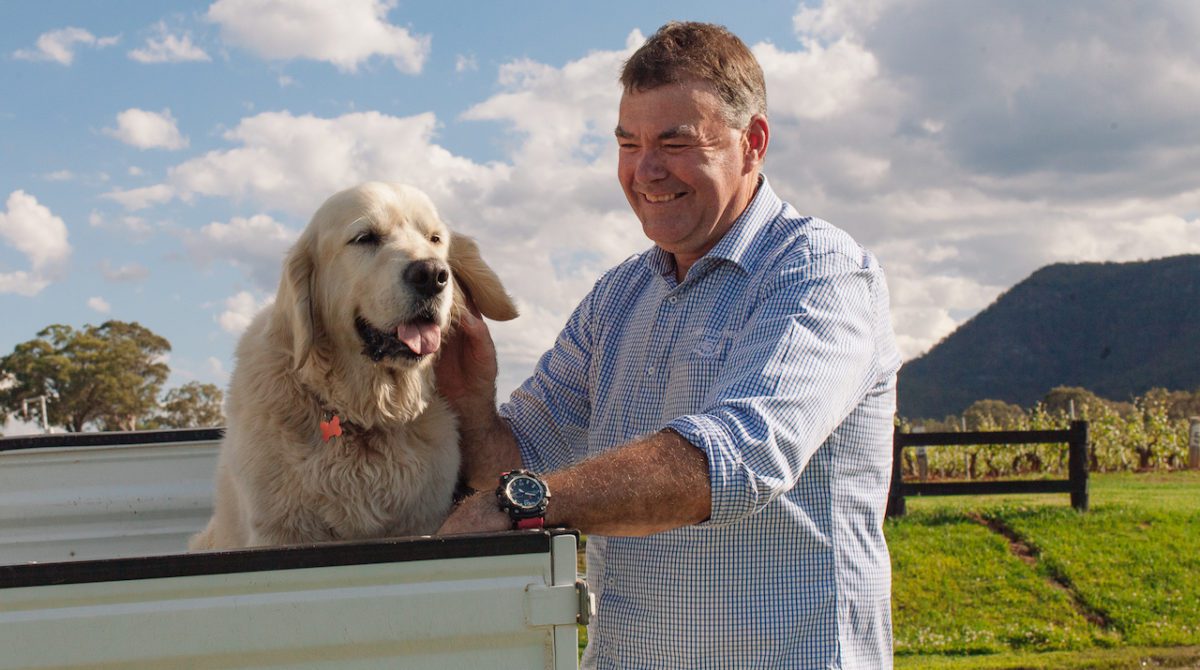Andrew Pengilly, the vineyard manager responsible for the vines that underpin the Tyrrell’s brand, has spent considerable time this year working on the company’s biosecurity plan.
Established in 1858, the winery has 290 acres (117ha) of vineyards in total, mostly in the Hunter Valley, with vines spread 16 kilometres north and six kilometres south of the Pokolbin winery and cellar door. Tyrrell’s also has a 65 acre (26ha) vineyard in Heathcote, Victoria, planted to Shiraz and Malbec.
Tyrrell’s vineyard holdings include 25 acres (10ha) of vines that are more than 100 years old.
With protection of these precious vines in mind, Andrew attended Vinehealth Australia’s Phylloxera Immersion Tour to Victoria’s Yarra Valley in late 2019, to learn first-hand about the ‘world’s worst agricultural pest’. This followed his participation in a NSW statewide phylloxera simulation run a few months prior, where government and industry preparedness was tested.
“The Phylloxera Tour really put the risks and consequences of a phylloxera outbreak into sharp focus for us,” Andrew says.
“We’ve been fine-tuning our biosecurity plan since then.”
Tyrrell’s biosecurity activities include regular machinery washdowns, keeping a visitor record, chlorine footbaths for visitors and locking all vineyard gates.
“We thoroughly wash down all machinery used in the vineyards on a weekly basis,” Andrew says.
“We do a lot of operations in the off season, including soil tillage, slashing and spraying, so our machinery needs to be thoroughly cleaned year-round.”
Tyrrell’s has a bunded concrete washdown pad with both fresh water and dam water sources available. It includes an evapotranspiration pit to capture and contain water used for cleaning machinery.
Footbaths are in place at the main vineyard office, and all visitors are asked to step into a chlorine solution to disinfest their shoes.
“Everybody who comes onto the site stands in the footbath for three minutes. We know it only needs to be 60 seconds to kill phylloxera, but we want to be absolutely sure,” Andrew says.
“We have a lot of visitors – tour groups from interstate or overseas, guests from Sydney, people arriving in helicopters, trade visitors. We don’t know where they’ve been prior, so we insist on the footbath.
“Most visitors are pre-arranged, so we notify people before they arrive that they will be standing in chlorine, so to wear appropriate shoes.”
Tyrrell’s is also working on a biosecurity plan for clothing that visitors wear into vineyards. Vinehealth Australia’s fact sheet ‘Biosecurity Planning for Vineyard Owners Hosting Visitors’ provides guidance on best practice management of clothing and footwear.
All Tyrrell’s vineyards are fenced, and gates are locked with bicycle locks so that only staff can get in and out easily.
“Shutting and locking gates is a reasonably new activity for us,” Andrew says.
“When the gates were open it was a free for all. People were coming into the vineyards all the time. Now with the gates shut, we don’t see the foreign vehicle tracks in the vineyards.”
Tyrrell’s has some biosecurity signage at vineyard entrances and has purchased additional Wine Tourism Biosecurity signs from Vinehealth Australia to assist with visitor education.
“We know that a big part of biosecurity is awareness and education and this is particularly important for us, given our focus on tourism. We have to inform people that they shouldn’t walk in our vineyards, and why. This is where we need to focus our efforts in the future,” Andrew says.
The future will also involve gradual replanting to phylloxera-tolerant rootstocks as an added insurance policy.
“When Murray Tyrrell was alive, he used to dabble in rootstocks, so we have a bit of history there,” Andrew says.
“The plan is to go to rootstocks gradually as we plant new vineyards or replant vineyards to new varieties such as Fiano and Gamay.
“We’re talking to nurseries and using the rootstock selector tool to work out what will be best for us. We need a drought tolerant rootstock, plus phylloxera resistance, plus nematode resistance, so we’re on the lookout.”
Andrew says the team at Tyrrell’s is conscious of the biosecurity risk associated with transporting winegrapes from the Heathcote vineyard in Victoria to the winery in Pokolbin.
“We’re continually monitoring the situation with phylloxera in Victoria and we’ll adjust our routes of travel accordingly and ensure we comply with all import requirements into NSW,” Andrew says.
“We need to adapt to challenges we’re facing with biosecurity, as well as climate, and make sure our vineyards are healthy and giving the winemakers the best grapes to work with each year.”
